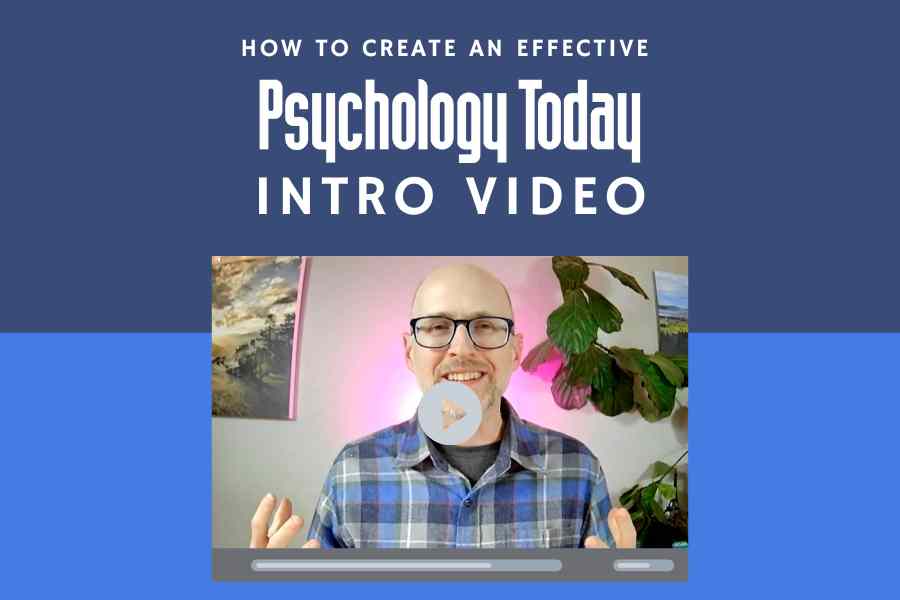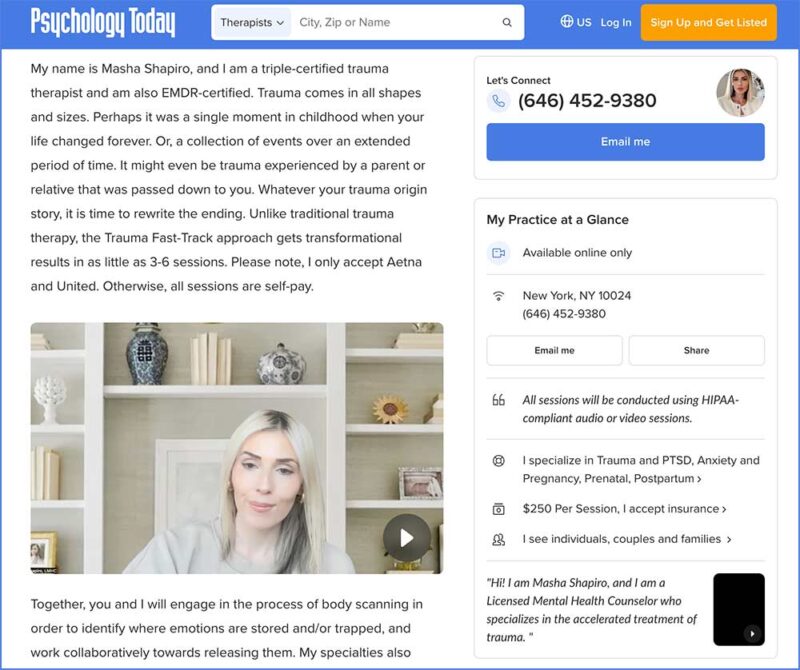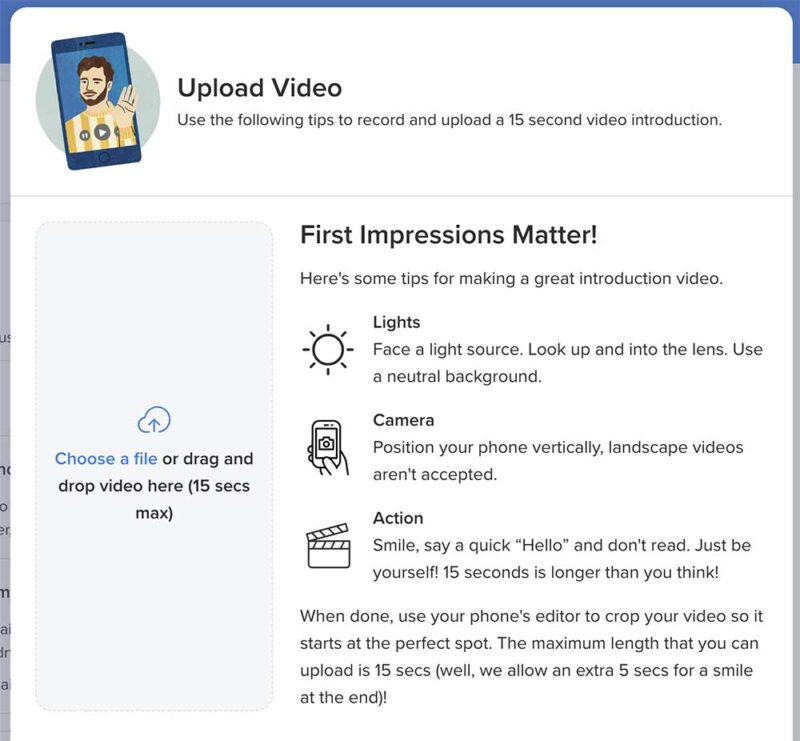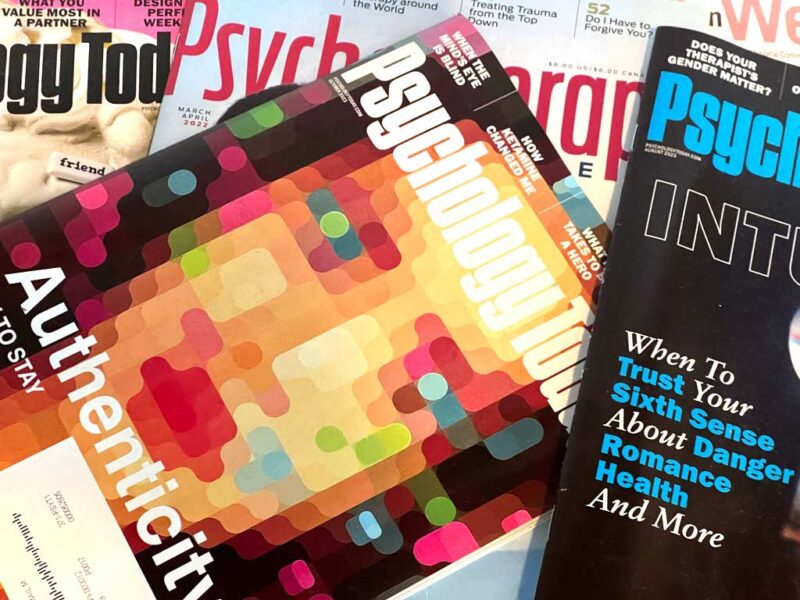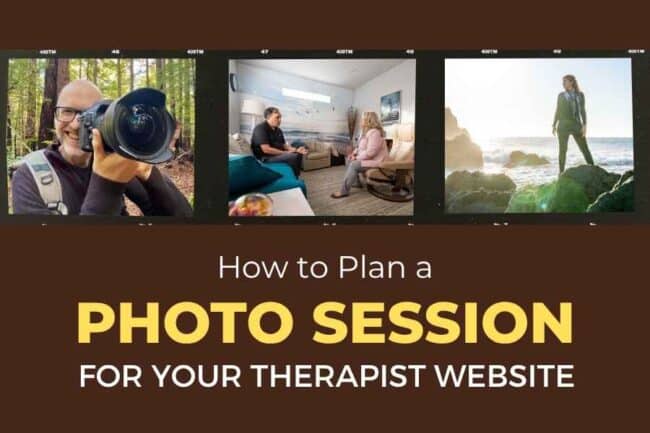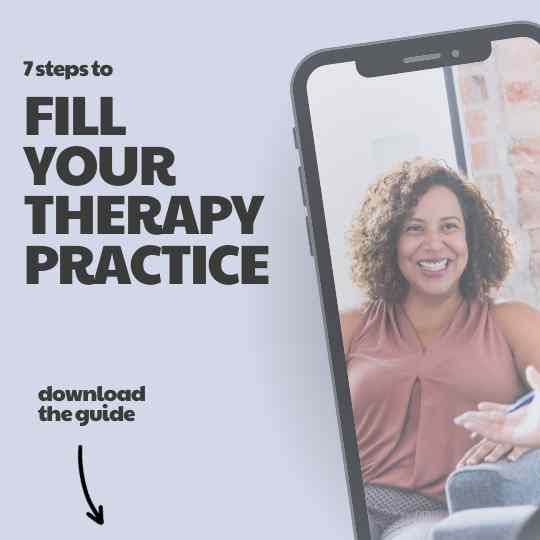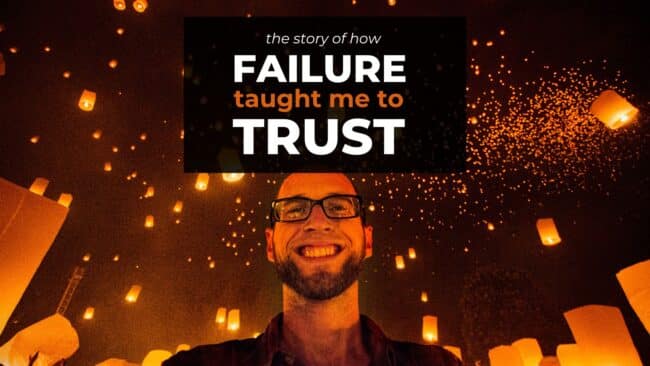Viewers retain 95% of a video’s message (compared to 10% when reading the text version). If you wonder why you need a Psychology Today video on your profile, that stat says it all.
For better or worse, Psychology Today has become a key part of therapist marketing. Some argue that it’s essential for visibility and credibility, while others believe that with the right strategies, therapists can thrive without it. I could go either way.
From my perspective, having a Psychology Today profile is a valuable tool in your marketing arsenal, but it’s not the end-all-be-all. I don’t love that the search results are random. I also wish the directory site gave do-follow backlinks, which are critical for SEO for therapists. However, if you are comitted to using the platform, the key to success is making the most of your profile when someone actually finds it.
Make Your Psychology Today Profile About Them, Not You
Don’t just post your credentials. Take the time to address your dream client’s pain points. Give them a teaser of what’s in it for them. Make a personal connection and inspire your dream client to reach out. While words are one path to this connection, creating a Psychology Today video is a more modern way of helping people know, like, and trust you. Plus …
As rumor has it, adding a Psychology Today video will give you a higher priority in the random algorithm.
In this post, I’ll guide you through the steps to create an engaging and effective Psychology Today video. From understanding the platform’s algorithm to best practices in video production, I’ll share insights and tips to help you stand out and attract the clients you are most passionate about helping. Let’s dive in and explore how you can make the most of your Psychology Today profile with video.
Video May Help Your Psychology Today Profile Get More Views
The Psychology Today algorithm is random. It is designed to rotate therapist profiles randomly within search results for a given area, such as a county, town, or zip code. This system aims to democratize visibility among therapists, ensuring that all profiles have an equal chance of appearing at the top of search results at different times.
However, this also means that a therapist’s profile could move from the first page to a much lower position without any changes to the profile itself, making visibility to potential clients unpredictable.
From what I’m hearing, adding a Psychology Today video gives your profile an algorithm boost.
Is this fact? No. But, as a therapist marketing coach who regularly keeps my ear to the pavement for the latest industry news, the rumors and whispers say “maybe.” It’s also worth mentioning that I’ve heard lots of theories over the years about Psychology Today algorithm hacks. Some therapists on Reddit swear that making regular updates to their profiles gives them a bump and makes them show up on page 1 more often.
Regardless of the truth in these hacks, incorporating a Psychology Today video into your profile can significantly enhance your appeal to potential clients. Videos allow therapists to convey their personality, therapeutic approach, and empathy more vividly than text alone, providing a more personal touch that can make a profile stand out. So, for that reason along, I highly recommend it.
What is the Purpose of Your Psychology Today Video?
Connection. Inspiration. Action. These are the three primary goals of your Psychology Today video. That means your video should:
- Humanize Your Practice: Your video is an opportunity to put a face and voice to your profile. It makes you more approachable and relatable, showing potential clients that they would be reaching out to a real person.
- Build Trust: Utilize the video to instill trust by conveying your communication style, tone of voice, and body language. This is your chance to make potential clients feel comfortable with the idea of reaching out to you.
- Highlight Your Expertise: Use the video to showcase your passion and expertise in your field. Explain briefly how you can help clients, providing a glimpse into your therapeutic approach in a way that text alone might not fully capture.
- Convey Empathy: Demonstrating empathy is critical. Acknowledge the struggles your potential clients are facing, and show that you understand their situation and have the skills to help them navigate their challenges.
- Showcase Personality: Let your genuine personality shine through. This helps potential clients feel a connection to you even before they’ve met you, increasing the likelihood they’ll reach out.
- Emphasize Transformation: Briefly touch on the transformation or outcomes clients can achieve by working with you. This could be feeling closer in their relationships, learning to communicate more effectively, or finding new ways to cope with anxiety or depression.
What to Say in Your Psychology Today Video
You only have 15 seconds to make a personal connection, show the viewer that you “get them,” and inspire them to reach out or visit your website. That’s a lot of pressure for a little bit of time. But, with the right framework and approach your Psychology Today video can turn random viewers into paying clients pretty quickly.
Most therapists begin their video by introducing themselves and providing their credentials. They talk about their modalities or how they treat “anxiety, depression, etc.” While something is better than nothing when it comes to your Psychology Today video, this approach is not doing a great job of making a personal connection. Instead, try using this formula:
- Address the Client Directly: From the start, make sure your content is client-centered. Your opening should directly address potential clients’ concerns and aspirations, making them feel seen and understood. Make it about them, not you. For example, “Struggling to slow down your racing mind?” or “Does it feel like the dog is higher up in the family priority list than you are?”
- Offer a Glimpse of What’s Possible: Paint a picture of what their life could look like with your help. For example, “Imagine being able to lay down at night and fall right to sleep.” or “It is possible to rekindle your relationship spark in daily life, the bedroom, and beyond.”
- Share What Makes You Different: Do you have a specific program or system that gets results faster than other therapists? For example, one of my clients has a Trauma Fast Track offering that uses a mix of EMDR, IFS, and other modalities to treat trauma effectively in 3-6 sessions. That’s a big, bold statement — and she starts her video with that. If you don’t have that “magic formula,” just highlight something about your approach. For example would be, “I’m Greg Goodman and I’ve been helping couples stop fighting and communicate better since 2006.”
- Provide a Clear Call to Action: End your video with a clear invitation for viewers to take the next step, whether it’s scheduling a free consultation or visiting your therapist website for more information. Make it easy for them to understand how to move forward with you.
How to Film Your Psychology Today Video
Below is a comprehensive list of best practices for filming your Psychology Today video. That said, I suggest first taking your camera and making a 15 second video of you saying anything you want. Then, upload it to Psychology Today as a placeholder. Just in case that rumor about video helping you with the Psychology Today algorithm is true, you want something up there now. As for creating a professional-looking video …
Psychology Today Video Guidelines
- 15 Seconds of Fame: The website says they limit the video length to 15 seconds … but, it then goes on to say they allow 5 extra seconds for your smile. To take it a step further, one of my clients has a 25 second video. So, the jury is out on how long you can actually record.
- Record in Portrait Orientation: While Psychology Today has loosened their requirements to allow you to film in portrait or landscape, think about the general stats of mobile use. With more than 60% of visitors looking at your profile on their phone, it makes sense to have a tall (portrait) not wide (landscape) video. This means recording it on your phone.
Lighting and Background
- Natural Light is Your Best Friend: Aim to film in a well-lit room with plenty of natural light. Position yourself so that the light falls onto your face. Avoid backlit setups where a strong light source is behind you, causing you to appear shadowed or silhouetted.
- Consistent Artificial Lighting: If natural light isn’t an option, invest in some softbox lights or ring lights. They help eliminate shadows and give your video a professional look. Here is a great, cheap ring light that works with both phones and laptops.
- Simple, Uncluttered Backgrounds: Choose a background that isn’t distracting. A clean, minimalistic setup helps keep the focus on you. If you’re filming in your office, a tidy space with a few elements that represent your therapy practice can add a personal touch without overwhelming the viewer.
- Don’t Blur Your Background: Let people see your office. Using the blur feature makes your video look like a stuffy work Zoom call. “Is she at home? In a coffee shop? On a beach? Is she even wearing pants?!” No one knows!
Camera Setup
- Looking at Eye-Level: Position your camera at eye level. This angle is the most flattering and creates a sense of direct conversation with your viewers. It’s all about making that virtual eye contact!
- Steady Does It: Use a tripod or a stable surface to prevent shaky footage. Stability is key to a professional-looking video.
Sound Matters
- Quiet on Set: Choose a quiet location to avoid background noise. Even the slightest sounds, like the hum of an air conditioner, can be distracting.
- Mic Up: While built-in microphones have come a long way, consider using an external microphone. Lapel mics or USB mics can significantly improve your audio quality, making your message clear and pleasant to listen to.
Presentation Tips
- Tilt Your Glasses: If you wear glasses like me, the light will reflect in them. You can counterbalance this by slightly tilting your glasses downwards. Experiment with it in the mirror and see how you can hide the tilt with your hair.
- Practice Makes Perfect: Rehearse your script but aim for a conversational tone. You want to come across as approachable and knowledgeable, not like you’re reading a teleprompter.
- Smile and Energy: Start with a smile and maintain a positive, energetic demeanor throughout. Your enthusiasm is contagious and will help keep viewers engaged.
Parting Thoughts
Your Psychology Today profile, enhanced with a personal video, bridges the gap between being just another name in a directory site and becoming the therapist of choice for potential clients. This article has walked you through the importance of such a video, breaking down not just the ‘why’ but the ‘how-to’ in creating content that connects, conveys empathy, and showcases your unique approach to therapy.
It’s clear that a well-crafted Psychology Today video can significantly elevate your profile, making you more relatable, trustworthy, and approachable to those seeking help. Remember, it’s not just about listing qualifications; it’s about making a human connection. As you embark on this creative endeavor, keep your focus on the client’s journey, your role as a guide, and the transformative power of therapy. This approach will not only set your profile apart but also align you closer with the clients you are most passionate about helping.

